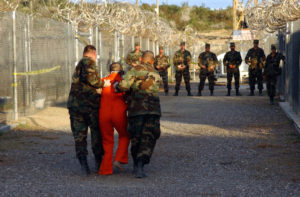Exhibit One in Any Future American War Crimes Trial
Even if the accusations against Abu Zubaydah had been true, what the CIA did to him—with the knowledge and approval of the highest government officials—is a prime example of the kind of still-unpunished crimes that officials such as Dick Cheney, George Bush and Donald Rumsfeld committed in the so-called global war on terror. A portrait of Donald Rumsfeld, the first secretary of defense under President George W. Bush. (thierry ehrmann / CC-BY-2.0)
1
2
3
A portrait of Donald Rumsfeld, the first secretary of defense under President George W. Bush. (thierry ehrmann / CC-BY-2.0)
1
2
3
When he “lost” his left eye under mysterious circumstances while in CIA custody, the agency’s concern again was not for his health. The December 2014 torture report produced by the Senate Select Committee on Intelligence (despite CIA opposition that included hacking into the committee’s computers) described the situation this way: with his left eye gone, “in October 2002, DETENTION SITE GREEN [now known to be Thailand] recommended that the vision in his right eye be tested, noting that ‘[w]e have a lot riding upon his ability to see, read, and write.’ DETENTION SITE GREEN stressed that ‘this request is driven by our intelligence needs [not] humanitarian concern for AZ.’”
The CIA then set to work interrogating Zubaydah with the help of two contractors, the psychologists Bruce Jessen and James Mitchell. Zubaydah would be the first human subject on whom those two, who were former instructors at the Air Force’s SERE (Survival, Evasion, Resistance, Escape) training center, could test their theories about using torture to induce what they called “learned helplessness,” meant to reduce a suspect’s resistance to interrogation. Their price? Only $81 million.
CIA records show that, using a plan drawn up by Jessen and Mitchell, Abu Zubaydah’s interrogators would waterboard him an almost unimaginable 83 times in the course of a single month; that is, they would strap him to a wooden board, place a cloth over his entire face, and gradually pour water through the cloth until he began to drown. At one point during this endlessly repeated ordeal, the Senate committee reported that Zubaydah became “completely unresponsive, with bubbles rising through his open, full mouth.”
Each of those 83 uses of what was called “the watering cycle” consisted of four steps:
“1) demands for information interspersed with the application of the water just short of blocking his airway 2) escalation of the amount of water applied until it blocked his airway and he started to have involuntary spasms 3) raising the water-board to clear subject’s airway 4) lowering of the water-board and return to demands for information.”
The CIA videotaped Zubaydah undergoing each of these “cycles,” only to destroy those tapes in 2005 when news of their existence surfaced and the embarrassment (and possible future culpability) of the Agency seemed increasingly to be at stake. CIA Director Michael Hayden would later assure CNN that the tapes had been destroyed only because “they no longer had ‘intelligence value’ and they posed a security risk.” Whose “security” was at risk if the tapes became public? Most likely, that of the Agency’s operatives and contractors who were breaking multiple national and international laws against torture, along with the high CIA and Bush administration officials who had directly approved their actions.
In addition to the waterboarding, the Senate torture report indicates that Zubaydah endured excruciating stress positions (which cause terrible pain without leaving a mark); sleep deprivation (for up to 180 hours, which generally induces hallucinations or psychosis); unrelenting exposure to loud noises (another psychosis-inducer); “walling” (the Agency’s term for repeatedly slamming the shoulder blades into a “flexible, false wall,” though Zubaydah told the International Committee of the Red Cross that when this was first done to him, “he was slammed directly against a hard concrete wall”); and confinement for hours in a box so cramped that he could not stand up inside it. All of these methods of torture had been given explicit approval in a memo written to the CIA’s head lawyer, John Rizzo, by Jay Bybee, who was then serving in the Justice Department’s Office of Legal Counsel. In that memo Bybee approved the use of 10 different “techniques” on Zubaydah.
It seems likely that, while the CIA was torturing Zubaydah at Jessen’s and Mitchell’s direction for whatever information he might have, it was also using him to test the “effectiveness” of waterboarding as a torture technique. If so, the agency and its contractors violated not only international law, but the U.S. War Crimes Act, which expressly forbids experimenting on prisoners.
What might lead us to think that Zubaydah’s treatment was, in part, an experiment? In a May 30, 2005, memo sent to Rizzo, Steven Bradbury, head of the Justice Department’s Office of Legal Counsel, discussed the CIA’s record keeping. There was, Bradbury commented, method to the CIA’s brutality. “Careful records are kept of each interrogation,” he wrote. This procedure, he continued, “allows for ongoing evaluation of the efficacy of each technique and its potential for any unintended or inappropriate results.” In other words, with the support of the Bush Justice Department, the CIA was keeping careful records of an experimental procedure designed to evaluate how well waterboarding worked.
This was Abu Zubaydah’s impression as well. “I was told during this period that I was one of the first to receive these interrogation techniques,” Zubaydah would later tell the International Committee of the Red Cross, “so no rules applied. It felt like they were experimenting and trying out techniques to be used later on other people.”
In addition to the videotaping, the CIA’s Office of Medical Services required a meticulous written record of every waterboarding session. The details to be recorded were spelled out clearly:
“In order to best inform future medical judgments and recommendations, it is important that every application of the waterboard be thoroughly documented: how long each application (and the entire procedure) lasted, how much water was used in the process (realizing that much splashes off), how exactly the water was applied, if a seal was achieved, if the naso- or oropharynx was filled, what sort of volume was expelled, how long was the break between applications, and how the subject looked between each treatment.”
Again, these were clearly meant to be the records of an experimental procedure, focusing as they did on how much water was effective; whether a “seal” was achieved (so no air could enter the victim’s lungs); whether the naso- or oropharynx (that is, the nose and throat) were so full of water the victim could not breathe; and just how much the “subject” vomited up.
Your support matters…Independent journalism is under threat and overshadowed by heavily funded mainstream media.
You can help level the playing field. Become a member.
Your tax-deductible contribution keeps us digging beneath the headlines to give you thought-provoking, investigative reporting and analysis that unearths what's really happening- without compromise.
Give today to support our courageous, independent journalists.





You need to be a supporter to comment.
There are currently no responses to this article.
Be the first to respond.